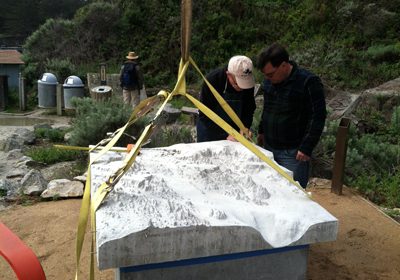Central Concrete Supply Co., the northern California business of U.S. Concrete Inc., has left its signature on a finely detailed, 3D model of the Point Lobos State Marine Reserve, located south of Monterey along the central coast of California.
Point Lobos State Park officials unveiled the grout and concrete model, 4-ft. square and 18 in. deep, during an early-May ribbon cutting ceremony. Placed on a conventional concrete pedestal at the park’s Whalers Cove area, the model is a principal reference for divers exploring a nearly 10,000-acre underwater landscape. The reserve harbors what Point Lobos enthusiasts characterize as “knife-edge structures as tall as skyscrapers; giant pinnacles undamaged by the erosion of their land-based counterparts; chasms barely wide enough to swim through; ledges dropping into unfathomable depths; topography that was above water during the last ice age, preserved much as it might have looked thousands of years ago when humans first camped on this shore.”
 |
| (above) Bay Area Underwater Explorers member Gary Banta used a CNC (computer numerical control) machine to carve the shape of the underwater topography at Point Lobos State Marine Reserve in special foam, which was then used to create a silicone shell mold for the concrete model. |
 |
A silicone mold for the model was crafted from a computer numerical control machine fabricating foam according to measurements provided by Bay Area Underwater Explorers and a survey team deploying California State University Monterey Bay’s high-resolution, multi-beam sonar equipment. Central Concrete’s Quality and Assurance Lab in San Jose tested mix samples best suited to curtailing small surface imperfections and holes, yielding a finished model with high level of topographical detail.
Lab staff chose a high-strength grout with white cement, sieved fine sand and various chemicals to meet the project’s stringent requirements. The 12,000 psi material’s admixture schedule includes high-range water reducers for optimal flow; viscosity modifiers to maintain cohesiveness; shrinkage reducing agents; defoamer to reduce air voids; and, microfibers for additional bonding. Central Concrete prepared a high-strength, lightweight concrete with macro structural fibers for a base layer.
The only way to experience the Point Lobos State Marine Reserve’s underwater landscape prior to the model’s dedication was to secure one of 30 permits issued daily to proficient divers. Even then, park officials note, visitors lacking the guidance of someone extremely familiar with the territory would be unlikely to know where they have been while observing extraordinary kelp forest, schools of fish, and friendly seals.
